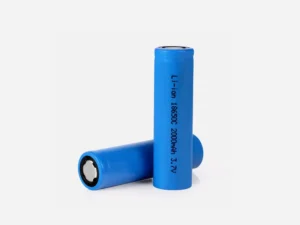Comparison: 14500 vs. 18650 Lithium Batteries
Lithium batteries play a central role in today’s tech-dominated environment, powering a wide range of applications from electric vehicles and marine vehicles to everyday household devices like flashlights, smartphones, and laptops. Among the common portable electric device batteries in the market, the 14500 and 18650 batteries stand out for their versatility and performance. In this article, we will compare and contrast both 14500 and 18650 batteries, exploring their similarities, differences, and applications.
What is a 14500 battery?

The 14500 battery is a rechargeable lithium-ion device with a cylindrical shape and various applications. The name “14500” refers to its diameter of 14 mm and a length of 50 mm. Its size is similar to an AA battery, often regarded as the rechargeable version of alkaline AA batteries.
What is a 18650 battery?

The 18650 battery is a cylindrical rechargeable device with a diameter of 18 mm and a height of 65 mm. Known for its standard industry size, the 18650 battery offers a capacity typically ranging from 1200mAh to 3600mAh.
Differences between 14500 and 18650 battery

1. Dimension:
The size of the batteries is a significant differentiating factor. The 18650 battery is generally larger than the 14500 battery, with dimensions of 18 mm by 65 mm, whereas the 14500 battery measures 14 mm by 50 mm.
2. Capacity:
The 18650 battery offers a larger capacity, typically ranging from 1200mAh to 3600mAh, compared to the smaller capacities of 500mAh to 800mAh found in the 14500 batteries. However, both batteries have a similar life cycle, with the 18650 batteries potentially having a longer life.
3. Performance:
The 18650 battery’s larger size and capacity result in a greater power output compared to the 14500 battery. While both batteries are lithium-ion and designed for longevity, the 14500 batteries have lower energy densities. However, if both batteries come from the same manufacturer, they may have similar energy densities.
4. Rate of Discharge:
The 18650 lithium battery supports a discharge rate of 10C and can charge up to 4.2V, while the 14500 lithium batteries typically support a discharge rate of 0.5-1C.
5. Voltage:
The 18650 battery has a higher voltage of 3.6V or 3.7V compared to the 3.2V nominal voltage of the 14500 battery. Due to its higher voltage and capacity, the 18650 battery is commonly used to power high-demand devices like laptops, drones, electric bikes, and power tools.
Similarities between 14500 and 18650 battery
The main similarity between these two lithium-ion battery types is their voltage, which can be 3.2V, 3.6V, 3.65V, or 3.7V. Both batteries can power the same devices, provided the battery compartments have adequate space. However, their capacity, discharge rate, and dimensions differentiate the two battery types from each other.
Applications of 14500 and 18650 Batteries
Both 14500 and 18650 batteries find applications in various fields. The 14500 lithium-ion battery is commonly used in portable electronic devices like remote-controlled toys, digital thermometers, and flashlights. It serves as an upgrade for devices that previously used AA batteries.
On the other hand, the 18650 battery’s higher capacity makes it ideal for powering consumer devices such as laptops, vapes, electric vehicles, and marine vessels.
Factors to Consider when Buying 14500 and 18650 Batteries
Before purchasing either type of lithium-ion battery, there are several factors to consider:
- Ensure the battery size matches the compartment size of your device.
- Consider the power requirements of your device to avoid malfunctions or damage.
- Always buy authentic batteries to meet safety and quality requirements.
- Choose batteries with faster charging times for uninterrupted usage.
By carefully considering these factors, you can maximize the performance and lifespan of your lithium-ion batteries.
